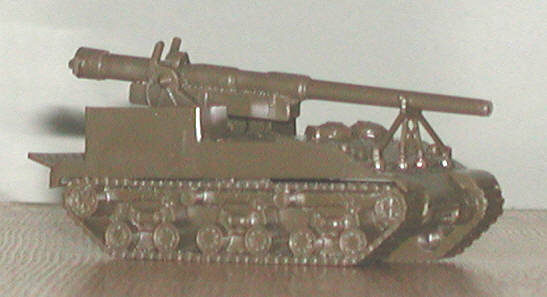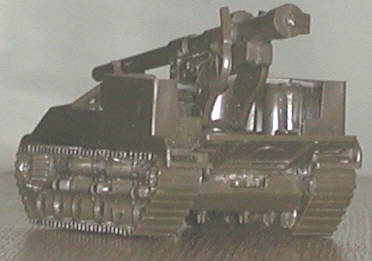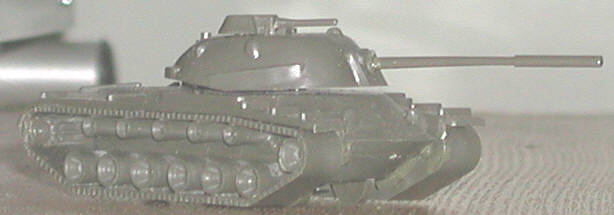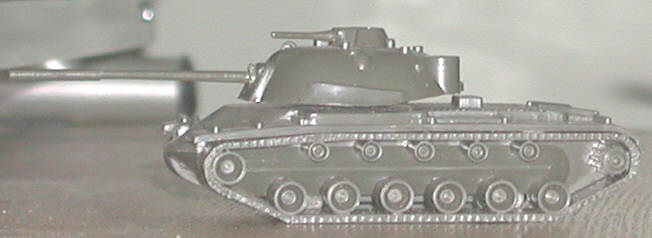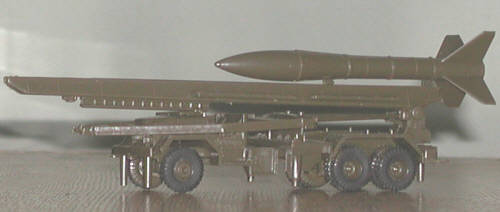Copyright 2008 T. Sheil & A. Sheil All Rights Reserved
Army Men Homepage
Minitanks
ROCO, Aurora, UPC and EKO
ROCO Minitanks were first imported by AHM (Associated Hobby Manufcaturers), a company that specialized in importing European-made hobby items. They were imported along with the Airfix soldiers, which AHM promoted as "Minimen." They first showed up in my old neighborhood around 1961. The original run of minitanks were made in 1/90 scale and included the US M4A1 Sherman tank, US M48 medium tank, US M47 tank, German Panther tank, German Panzer 4 and Soviet JS III "Stalin" heavy tank. They were displayed on a small platform in the hobby shop's showcase. Customers would say which tank they wanted, and the counterman would retrieve them from plain gray boxes on a back shelf. The tanks were packed in a simple plastic bag along with a couple of decals: white stars for US, red stars for Russian and Panzer crosses for the Germans. It was not long before ROCO had added trucks, German half-tracks, the Honest John rocket and launcher and more tanks. The cost per tank in those days was twenty-five cents. A dollar could buy us two tanks and a box of Airfix soldiers.
I remember when the shop owner displayed ROCO tanks that he had painted in camouflage. He was very happy to tell us how he did it and which paints he used. As a result, the Testors sets of "military flats" sold brislky.
The kids my age had our little arms races, trying to amass the most powerful tanks and ignoring anything else. There was a run on Jadgdtigers, King Tigers, M48s, M103 heavy tanks, British Centurions and Conquerors. What with the Cold War, nobody wanted to have a Russian army.
Aurora came out with its Rat Patrol and Anzio Beach sets, each of which had their version of the ROCO vehicles. Aurora also had its range of Minitank copies called Military Midgets. UPC and Eldon sold kits that were exact copies of ROCO vehicles. Later, I came across the EKO vehicles that were pretty much copies of ROCO and Roskopf vehicles.
ROCO eventually jettisoned its 1/90 vehicles. Early on, ROCO made the switch to HO 1/87 scale. Their newer M48 and M47 tanks dwarfed the older model, which was actually 1/100 and may have been copied from Roskopf. Even the 1/90 M4A1 looked shrimpy when they brought out their 1/87 Sherman tank. Prices rose in the 1960s, but were still reasonable. When I see the current prices of things by the company that took over ROCO, I want to shudder. The price of some models is 100 times what we paid in 1962.
My original collection was lost in 1985 while in the midst of a disastrous move. I have acquired a few tanks in the past few years online, including a few from the Aurora sets. I still love the little tanks. All these years later, my favorites are the ones they had that first year they were available to us: US M4A1 Sherman tank, German Pz V Panther tank, the undersize M47 and M48 tanks and the German half track. I wish I had the molds for them!
The Sherman M4A1
This was the first HO scale tank we had. They were 25 cents apiece back in the 1960s. The model is of an M4A1 version of the Sherman tank with the late-war horizontal volute suspension. Size is about 1/90 - smaller than HO but larger than 1/100. The ROCO version came with a machine gun by the turet hatch. Ours lost its gun. EKO and Aurora copied it. The EKO version had a longer cannon barrel, probably to simulate the later 76mm gun. It also has a larger antennae bulge on the rear turret. For a time, EKO would sell its Shermans with a monofilament antenna glued into the turret.
HO tanks usually had a set of rollers in the floor to make playing with them easier. Only the EKO copies pictured here retained their wheels.
Aurora added a copy of its M4A1 in its Anzio Beach model kit. None of those tanks came with rollers, although the space and clip for them were on the hull floor.
Some time around 1970, ROCO replaced the M4A1 with a different version in 1/87 scale. EKO continues ot make its copies.
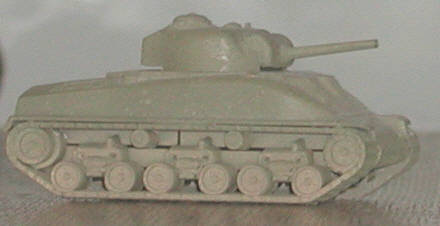
ROCO M4A1 Sherman in 1/90 scale | 
Eko Copy - not longer barrel, probably to represent the 76mm gun. |

ROCO M4A1 and Aurora copy | 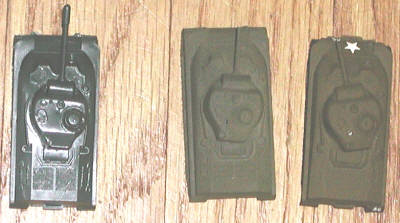
Overhead view of Eko, Roco and Aurora Shermans |
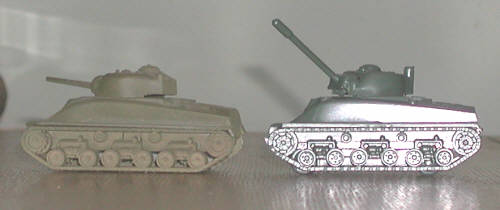
Side view: ROCO and EKO | 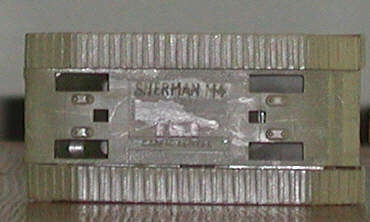
Botom of ROCO - wheels are missing |
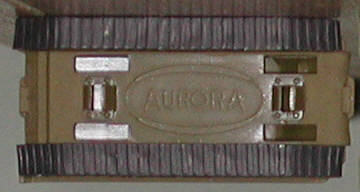
Aurora underside - wheels were not included in Anzio Beach kits | 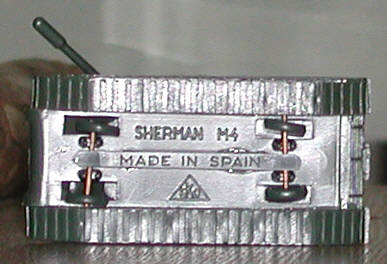
EKO underside wit hwheels |
| |
M36 "Jackson" Tank Destroyer with 90mm Gun
The M46 appeared late in World War II. Its 90mm gun could match anything the Germans had. The ROCO model cme with a machine gun on the turret. The Eko copies did not have the machine-gun. The scale of this tank is close to 1/87.
 | 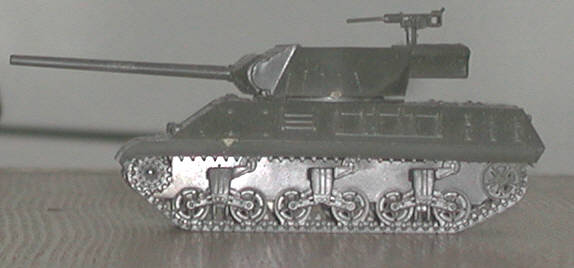
ROCO M36 with machine gun on turret |
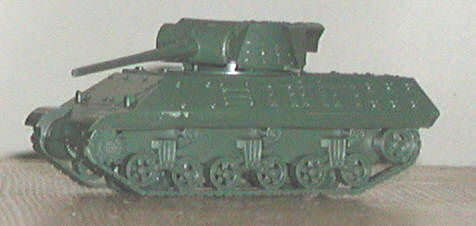
EKO copy. Gun does not move as well, no machine gun on turret | 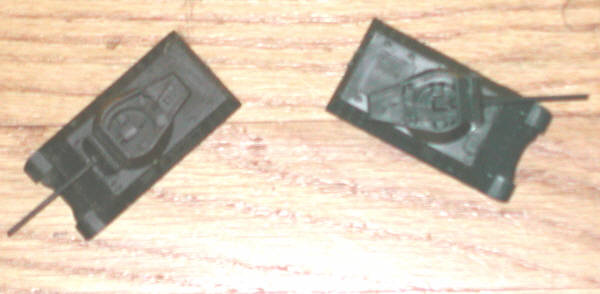
Top view, ROCO and EKO |
M40 Self-Propelled 155mm Howitzer
The M40 was a self-propelled 155mm artillery pieces mounted on a lengthened and widened Sherman M4 chassis. ROCO made it and the others copied it. The scale of the ROCO model was close to 1/87 and may even be a bit larger. It dwarfed ROCO's original M4A1 Sherman tank.
The M40 is one of those military anomalies common ot ROCO. The actual vehicle saw little or no service in World War II, arriving too late. It replaced the M12 self-propelled 155mm gun.
The Panther PZ V
When German forces first encountered the Soviet T-34, they were stunned. The T-34 made such an impression that Gerrman designers used it as a basis for a new armored fighting vehicle. The result was the Panzerr V Panther. Armed with a very powerful gun and protected by superb armor, the Panther was formidable. The first version that appeared in mid-1943 had some mechanical problems. Once the bugs were worked out, the Panther proved to be a strudy, powerful and maneuverable tank.
The irony here is that the most powerful German tanks, the Panther and Tiger and their variants, only appeared on the battlefield once the Germans started losing the War. They could slow the Allies, but not stop them.
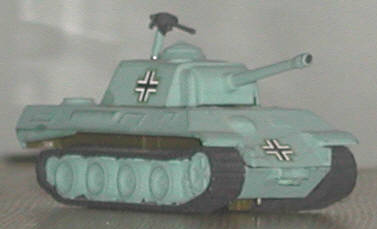
This is the Aurora version from Anzio Beach. Barrel is short. This is not our paint work. Odd color for a panzer. | 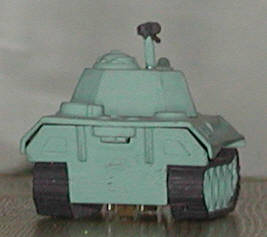 |
 | |
| |
| |
Panzer 4
The Panzer 4 was initially used as a close-support tank armed with a light 75mm howitzer. It soon became a main battle tank. The reliable Panzer 4 was upgunned and up-armored. It also served as the basis of various self-propelled guns, tank destroyers, anti-aircraft anks and assault guns.
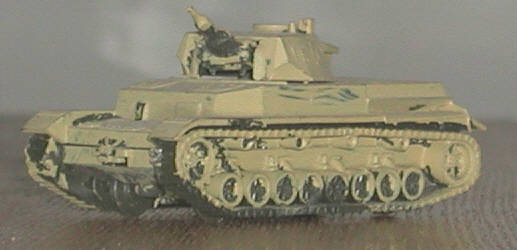
These tanks were already painted when we acquired them | 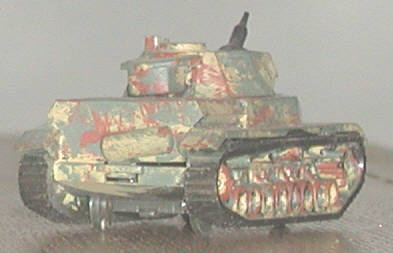 |
| |
| |
| |
Wirblewind ad Ostwind
With the decline of the Luftwaffe, greater emphasis was made on air defense. Armored anti-aircraft vehicles were necessary to provide air defense for armored formations. The Wirblewind and Ostwind used the versatile Panzer IV. They could be used against air and ground targets.
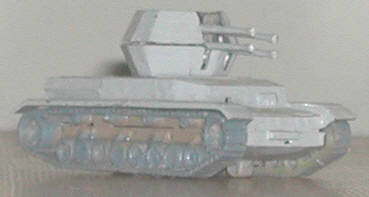
Aurora copy of the ROCO Wirblewind 20mm Flakpanzer. | 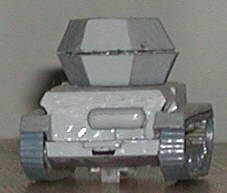
This is not our paint work! |
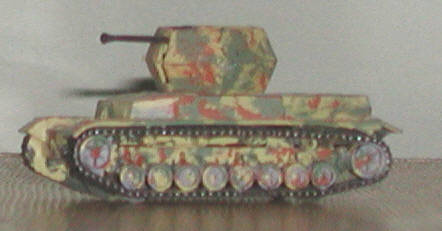
Ostwind Flakpanzerwith 37mm gun. It was painted when we acquired it. | |
Panzer 3
The Panzer 3 was the main battle tank of the German forces from 1939 to mid-1943. It was upgunned gradually from a 37mm gun to a short and then long 50mm gun. A close support version with a short 75mm gun came later.
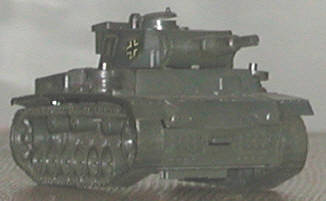
The Panzer III was Germany's primary medium tank until mid-1943 | 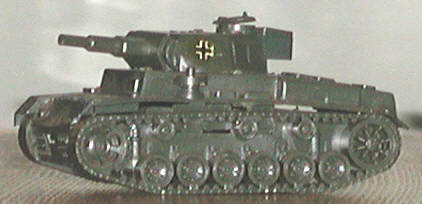
This Pz III has the short 50mm main gun. |
| |
| |
Sturmgeschutz
The Sturmgeschutz was an assault gun. Its purpose was originally to launc ha head-on attack against fortified positions. Later, the long barreled gun seen below replaced the small howitzer. This allowed the Sturmgeschutz to act as a tank destroyer.
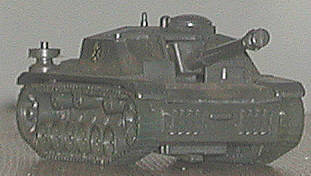 | 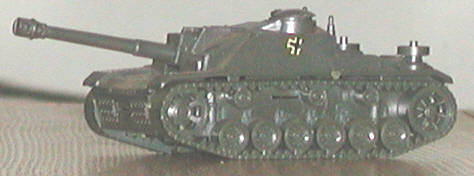
This is the Stug with the long-barrelled 75mm gun. Earleir versions had the short 75mm howitzer. Many later Stugs received additional armor skirting on the sides. |
| |
| |
Half Tracks
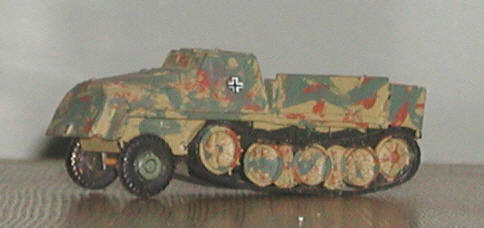
Plain version. (This was not painted by us.) | 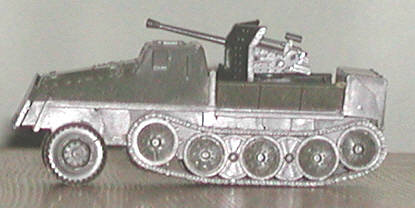
Anti-aircraft version with the 37mm gun. |
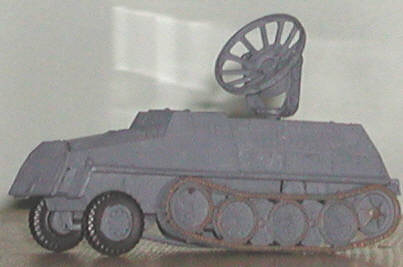
This vehicle has the sound detection device. Sound was used to detect and locate aircraft in the days before portable radar. | |
| |
| |
The First M47
The 50 Year Interim Tank
When the Army started developing a new Main Battle Tank to repalce the M26 Pershing and M46 Patton, the Korean war broke out. A new tank was needed to fill that gap until the better tanks' development was complete. The M47 Patton rolled off the assembly line in 1951. It had thick armor and a 90mm gun. The tank was reliable, maneuverable, and had good hitting power for its day. The M47 remained until it was repalced by the Main Battle Tank, the M48. Some M47s continued in US ervice with the National Guard. Others went to US allied such as France, Italy, Spain, Iran, Jordan, Austria and Pakistan. An upgrade kit was produced in the 1970s to bring M47s up to modern standards, and many allies bought them. They fought in the Indo-Pakistani Wars, 1967 Six-day Arab Israeli War and even the Balkan wars of the 1990s. The last army to use them was Croatia, who scrapped them after the war with Serbia was over. The Interim Tank was in use for five decades.
The early ROCO model is identical to that issued by Roskopf. Aside from the wheels and underside markings, the EKO and Aurora versions are identical, too. The scale is about 1/90 to 1/100. ROCO replaced theirs with a more detailed 1/87 scale model in the mid-1960s. As of their 2008 catalogue, EKO of Spain still manufactures the old M47. Like its real-life counterpart, it has lasted over five decades.
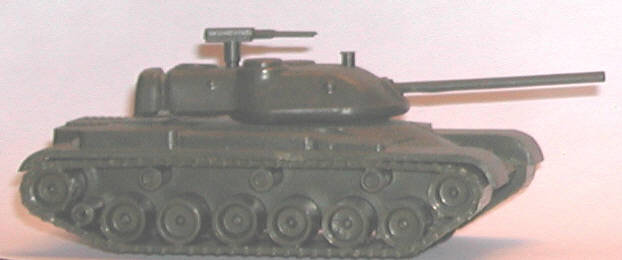
ROCO original M47. Idler is behind rear road wheel, which is correct. | 
Aurora copy. Yes, the barrel is bent! Note the idler is in front of the first road wheel. |

| 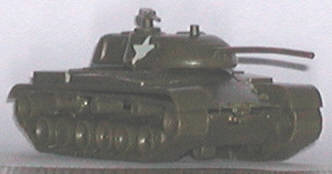
Aurora copy front. |

Lettering on bottom reads AUSTRIA and M47 | 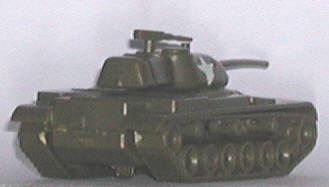
Aurora copy rear |

ROCO, EKO and Aurora M47s. Note odd hatch placement on the EKO model. It also has its idler in front. | |
The First M48
Cold War American Main Battle tank
The M48 was the main battle tank for the US and many of its clients during the Cold War Era. Earlyer versiosn was armed wit hthe 90mm gun. The last version had a 105mm fgun. Many were urgraded to the 105mm standard in the 1970s. The M48 performed well invarious conflicts for the US and its allies. The first version made by ROCO was identical to Roskopf's model and to the copy by EKO.
Honest John Missile
One of the wodner weapons of the 1950s, the Honest John missile was a portable weapons system. The missile, which could carry conventional or tactical nuclear weapons, was carried on its truck-mounted launcher. The ROCO model had a white missle. The one shown here is the UPC copy with olive-drab missile.
Trucks
The 2 1/2 ton truck, known as the "deuce and a half", was one of the greatest miltiary assets of all time. Tough, reliable and the right size for many missions, it remained in the US inventory right into the next century. Little did I know when we first bought models these that I would be spending a lot of time in a real one.
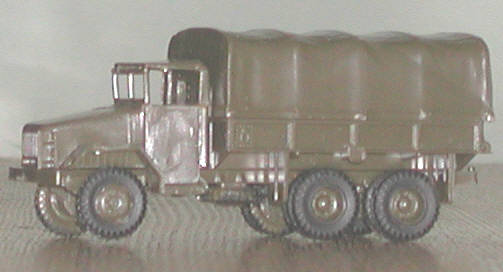
Deuce and a half truck. | |
| |
| |
Tiger Tank
The Tiger I and II Tanks wreaked havoc on Allied armor. With thick frontal armor and a pwoerful 88mm gun, the Tigers seemed unstoppable. Tigers first appeared in Tunisia in 1943. There were too few to make a difference. Later, Tiger Tanks would prove daunting adversaries on the Eastern Front. Western Allies encountered them in Western Europe. At the time, Allied tank guns were not powerful enough to penetrate the Tiger's armor. The real bane of Tiger tanks was allied air power. Slow-moving vehicles, no matter how well-armored, were easy targets for pilots.
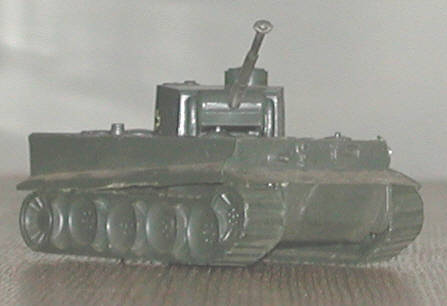
Tiger tank by Eko. | 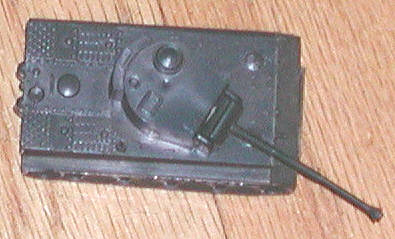
The Tiger by Eko is smaller than HO and may be a copy of a Roskopf model. |
| |
| |
Click here to return to the main page












